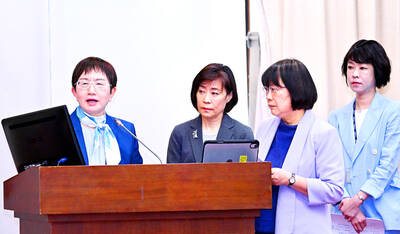Contract chipmaker Powerchip Semiconductor Manufacturing Corp (力積電) yesterday said revenue would gradually pick up in the second half of this year due to restocking demand and an optimized product portfolio in response to growing demand for artificial intelligence (AI) applications.
The Hsinchu-based chipmaker has been adjusting its product portfolios for the past two years with the aim of meeting demand from major customers, who were diversifying from China amid geopolitical risks, Powerchip president Brian Shieh (謝再居) told shareholders during the company’s annual general meeting in Hsinchu yesterday.
Powerchip is also developing a new process technology to make power management chips, vying for business opportunities in the Internet of Things (IoT), AI, high-performance computing and electric vehicle arenas, he said.

Photo: Grace Hung, Taipei Times
“With all those preparations and product line adjustments, we hope the effect will emerge from the second half to the first half of next year after customers reduce their inventory to normal levels,” Shieh said. “With capacity from the new fab in [Miaoli County’s] Tongluo Township (銅鑼) coming online in the second half, we anticipate the company’s revenue would gradually recover.”
Powerchip’s revenue fell 5.3 percent year-on-year to NT$14.5 billion (US$449 million) in the first four months of this year, following a 42 percent annual decline to NT$44 billion last year due to inventory adjustments.
Through product optimization, Powerchip is also looking to fend off rising competition from Chinese chipmakers, Shieh said.
China’s biggest chipmaker, Semiconductor Manufacturing International Corp (中芯), and Nexchip Semiconductor Corp (晶合) are major rivals to Powerchip.
Chinese companies expanded their capacity last year to produce display ICs, CMOS image sensors and power management chips using mature process technologies, but they had to drastically slash prices to compete for market share, Powerchip said.
Powerchip is also developing advanced “wafer-on-wafer” packaging technology as demand for devices such as PCs and smartphones with generative AI applications increases, Shieh said.
Powerchip plans to expand its product offerings to match customers’ demand for “single-level-cell” NAND and high-density NOR flash memory chips used in networking, mobile phones, IoT and computer peripherals, he said.
The company also plans to produce gallium nitride chips by rejuvenating its less-advanced 8-inch fabs, as well as power semiconductors including metal-oxide-semiconductor field-effect transistors and insulated gate bipolar transistors, he added.
Powerchip shareholders yesterday approved a proposal not to pay a cash dividend after the chipmaker lost NT$1.6 billion, or losses per share of NT$0.4, last year.
The company also booked NT$10.3 billion in idled manufacturing equipment losses and expenditures of NT$2.4 billion for the opening of the new fab in Tongluo Township.
The company last month said that it was approaching the break-even level last quarter as customers have reduced their inventory of chips used in consumer electronics such as smartphones, PCs and TVs to healthy levels.
Automotive and industrial chips were still in the process of inventory digestion, it said.

‘SWASTICAR’: Tesla CEO Elon Musk’s close association with Donald Trump has prompted opponents to brand him a ‘Nazi’ and resulted in a dramatic drop in sales Demonstrators descended on Tesla Inc dealerships across the US, and in Europe and Canada on Saturday to protest company chief Elon Musk, who has amassed extraordinary power as a top adviser to US President Donald Trump. Waving signs with messages such as “Musk is stealing our money” and “Reclaim our country,” the protests largely took place peacefully following fiery episodes of vandalism on Tesla vehicles, dealerships and other facilities in recent weeks that US officials have denounced as terrorism. Hundreds rallied on Saturday outside the Tesla dealership in Manhattan. Some blasted Musk, the world’s richest man, while others demanded the shuttering of his

ADVERSARIES: The new list includes 11 entities in China and one in Taiwan, which is a local branch of Chinese cloud computing firm Inspur Group The US added dozens of entities to a trade blacklist on Tuesday, the US Department of Commerce said, in part to disrupt Beijing’s artificial intelligence (AI) and advanced computing capabilities. The action affects 80 entities from countries including China, the United Arab Emirates and Iran, with the commerce department citing their “activities contrary to US national security and foreign policy.” Those added to the “entity list” are restricted from obtaining US items and technologies without government authorization. “We will not allow adversaries to exploit American technology to bolster their own militaries and threaten American lives,” US Secretary of Commerce Howard Lutnick said. The entities

Minister of Finance Chuang Tsui-yun (莊翠雲) yesterday told lawmakers that she “would not speculate,” but a “response plan” has been prepared in case Taiwan is targeted by US President Donald Trump’s reciprocal tariffs, which are to be announced on Wednesday next week. The Trump administration, including US Secretary of the Treasury Scott Bessent, has said that much of the proposed reciprocal tariffs would focus on the 15 countries that have the highest trade surpluses with the US. Bessent has referred to those countries as the “dirty 15,” but has not named them. Last year, Taiwan’s US$73.9 billion trade surplus with the US

Prices of gasoline and diesel products at domestic gas stations are to fall NT$0.2 and NT$0.1 per liter respectively this week, even though international crude oil prices rose last week, CPC Corp, Taiwan (台灣中油) and Formosa Petrochemical Corp (台塑石化) said yesterday. International crude oil prices continued rising last week, as the US Energy Information Administration reported a larger-than-expected drop in US commercial crude oil inventories, CPC said in a statement. Based on the company’s floating oil price formula, the cost of crude oil rose 2.38 percent last week from a week earlier, it said. News that US President Donald Trump plans a “secondary